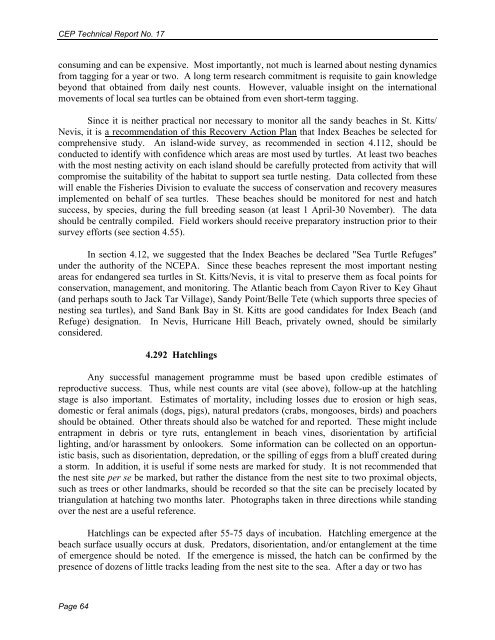Sea Turtle Recovery Action Plan for St. Kitts and Nevis - WIDECAST
Sea Turtle Recovery Action Plan for St. Kitts and Nevis - WIDECAST
Sea Turtle Recovery Action Plan for St. Kitts and Nevis - WIDECAST
Create successful ePaper yourself
Turn your PDF publications into a flip-book with our unique Google optimized e-Paper software.
CEP Technical Report No. 17<br />
consuming <strong>and</strong> can be expensive. Most importantly, not much is learned about nesting dynamics<br />
from tagging <strong>for</strong> a year or two. A long term research commitment is requisite to gain knowledge<br />
beyond that obtained from daily nest counts. However, valuable insight on the international<br />
movements of local sea turtles can be obtained from even short-term tagging.<br />
Since it is neither practical nor necessary to monitor all the s<strong>and</strong>y beaches in <strong>St</strong>. <strong>Kitts</strong>/<br />
<strong>Nevis</strong>, it is a recommendation of this <strong>Recovery</strong> <strong>Action</strong> <strong>Plan</strong> that Index Beaches be selected <strong>for</strong><br />
comprehensive study. An isl<strong>and</strong>-wide survey, as recommended in section 4.112, should be<br />
conducted to identify with confidence which areas are most used by turtles. At least two beaches<br />
with the most nesting activity on each isl<strong>and</strong> should be carefully protected from activity that will<br />
compromise the suitability of the habitat to support sea turtle nesting. Data collected from these<br />
will enable the Fisheries Division to evaluate the success of conservation <strong>and</strong> recovery measures<br />
implemented on behalf of sea turtles. These beaches should be monitored <strong>for</strong> nest <strong>and</strong> hatch<br />
success, by species, during the full breeding season (at least 1 April-30 November). The data<br />
should be centrally compiled. Field workers should receive preparatory instruction prior to their<br />
survey ef<strong>for</strong>ts (see section 4.55).<br />
In section 4.12, we suggested that the Index Beaches be declared "<strong>Sea</strong> <strong>Turtle</strong> Refuges"<br />
under the authority of the NCEPA. Since these beaches represent the most important nesting<br />
areas <strong>for</strong> endangered sea turtles in <strong>St</strong>. <strong>Kitts</strong>/<strong>Nevis</strong>, it is vital to preserve them as focal points <strong>for</strong><br />
conservation, management, <strong>and</strong> monitoring. The Atlantic beach from Cayon River to Key Ghaut<br />
(<strong>and</strong> perhaps south to Jack Tar Village), S<strong>and</strong>y Point/Belle Tete (which supports three species of<br />
nesting sea turtles), <strong>and</strong> S<strong>and</strong> Bank Bay in <strong>St</strong>. <strong>Kitts</strong> are good c<strong>and</strong>idates <strong>for</strong> Index Beach (<strong>and</strong><br />
Refuge) designation. In <strong>Nevis</strong>, Hurricane Hill Beach, privately owned, should be similarly<br />
considered.<br />
4.292 Hatchlings<br />
Any successful management programme must be based upon credible estimates of<br />
reproductive success. Thus, while nest counts are vital (see above), follow-up at the hatchling<br />
stage is also important. Estimates of mortality, including losses due to erosion or high seas,<br />
domestic or feral animals (dogs, pigs), natural predators (crabs, mongooses, birds) <strong>and</strong> poachers<br />
should be obtained. Other threats should also be watched <strong>for</strong> <strong>and</strong> reported. These might include<br />
entrapment in debris or tyre ruts, entanglement in beach vines, disorientation by artificial<br />
lighting, <strong>and</strong>/or harassment by onlookers. Some in<strong>for</strong>mation can be collected on an opportunistic<br />
basis, such as disorientation, depredation, or the spilling of eggs from a bluff created during<br />
a storm. In addition, it is useful if some nests are marked <strong>for</strong> study. It is not recommended that<br />
the nest site per se be marked, but rather the distance from the nest site to two proximal objects,<br />
such as trees or other l<strong>and</strong>marks, should be recorded so that the site can be precisely located by<br />
triangulation at hatching two months later. Photographs taken in three directions while st<strong>and</strong>ing<br />
over the nest are a useful reference.<br />
Hatchlings can be expected after 55-75 days of incubation. Hatchling emergence at the<br />
beach surface usually occurs at dusk. Predators, disorientation, <strong>and</strong>/or entanglement at the time<br />
of emergence should be noted. If the emergence is missed, the hatch can be confirmed by the<br />
presence of dozens of little tracks leading from the nest site to the sea. After a day or two has<br />
Page 64
















